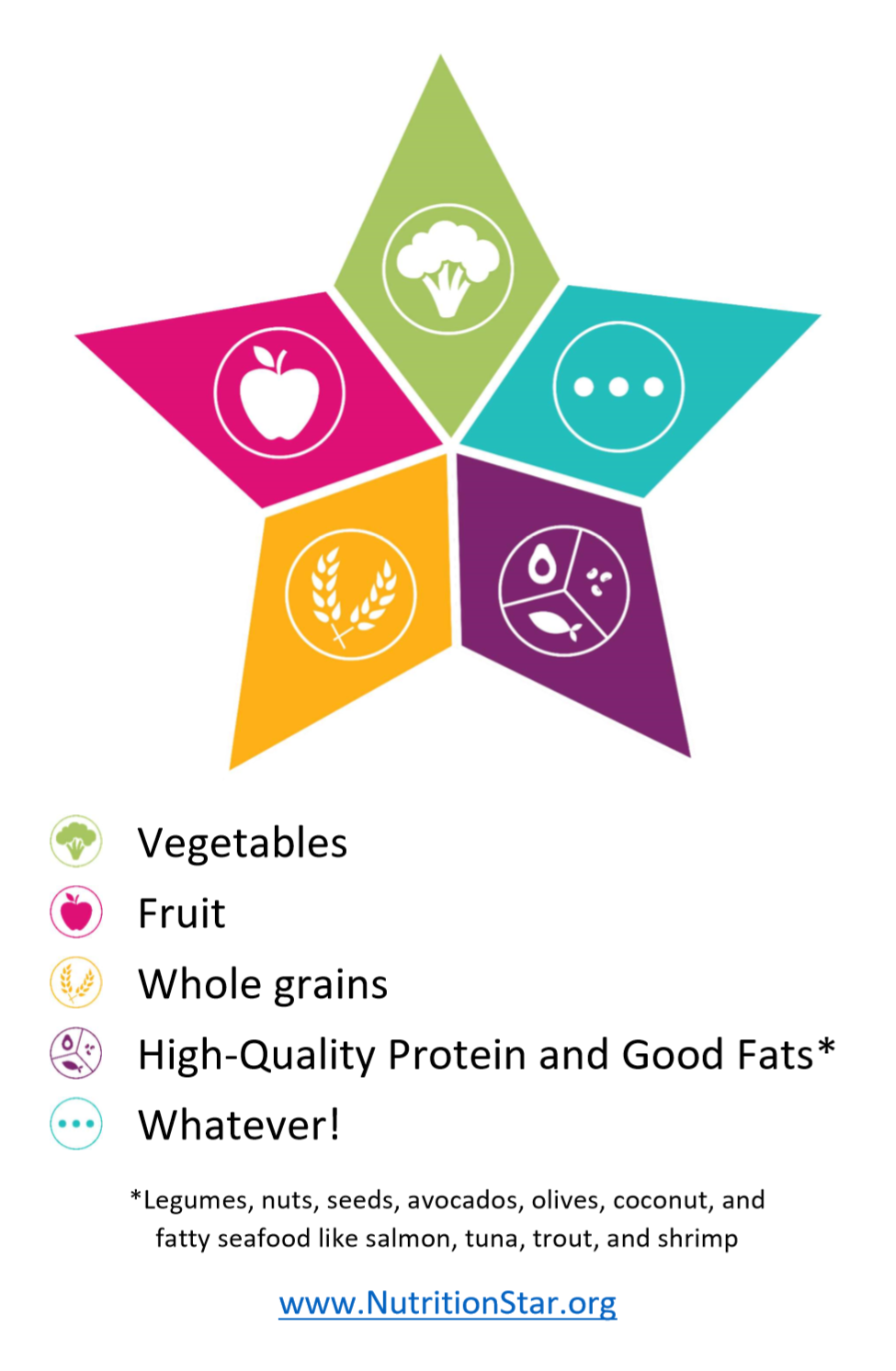 The 4:1 Rule is Project Simplify Health’s primary healthy eating strategy. It recommends that you try hard to:
The 4:1 Rule is Project Simplify Health’s primary healthy eating strategy. It recommends that you try hard to:
Eat at least four healthily-prepared plant- and/or fatty seafood-based food (i.e, anything from the four healthy diamonds of the Nutrition Star, AKA “4-Diamond” or “4◊” foods) for every “whatever” food (≥4:1 ratio):
 Two crucial qualities of The 4:1 Rule are simplicity (at least in concept) and flexibility, without which it cannot be livable long-term. A major objective of Project Simplify Health is to find that magical intersection between effectiveness (what’s necessary for amazing long-term health and weight loss) and livability (for most people). We believe strongly that The 4:1 Rule finds this magic, and provides an umbrella under which the grand majority of folks who have a desire to eat healthily may set up camp. And we hope that you will agree.
Two crucial qualities of The 4:1 Rule are simplicity (at least in concept) and flexibility, without which it cannot be livable long-term. A major objective of Project Simplify Health is to find that magical intersection between effectiveness (what’s necessary for amazing long-term health and weight loss) and livability (for most people). We believe strongly that The 4:1 Rule finds this magic, and provides an umbrella under which the grand majority of folks who have a desire to eat healthily may set up camp. And we hope that you will agree.
There is increasingly overwhelming evidence¹ that the more that you can replace high-cholesterol and fatty animal-based and processed foods with healthily-prepared plant-based foods, the healthier and slimmer you’ll be. Other studies make it clear that fatty seafood is also healthy.
The power of plants and fatty seafood
Indeed, there is great power in eating mostly healthily-prepared plants and fatty seafood. Specifically, there are four properties of most of these foods that allow you to be able to eat more food – all the while moving towards a healthier weight and significantly improving your health:
- Most have a low caloric density (nuts and seeds are among the exceptions), so you can usually eat a large volume without gaining weight.
- Your body has to work harder to convert them into body fat, so you can actually consume somewhere around 15-20% more calories when eating such food, without gaining weight! Think about it – more calories of already low caloric density foods? That’s a LOT of food you are given permission to eat, and that’s one of the greatest keys to long-lasting weight loss and health!
- Plants have lots of fiber and complex carbohydrates, including starches (which expand in the stomach), all of which are satiating. Animal-based and processed foods have no fiber, and although we may find them satiating, they are more addicting and eventually leave us craving more.
- Plants and fatty seafood are full of nutrients, including vitamins and antioxidants, thus meeting your body’s nutrient needs and reducing cravings. Most animal-based and processed foods provide little nutrition, even when fortified.
Where’s the Protein?
Many people are unaware that many plant-based foods have lots of protein, especially dark greens, legumes, whole grains, nuts and seeds – even potatoes and corn have some protein. In fact, if you eat a nice variety of different types of plants, you will get 40-50 (or more) grams of protein each day, just from just the plants you eat! Obviously fatty seafood (e.g., salmon, tuna, trout, sardines, shrimp) is also packed with protein.
An almost unlimited menu
As long as you keep the “whatever” portion below 20% of your total intake, you may eat “whatever” you want! “Whatever” literally means “whatever!” It can be healthy or less healthy, depending on your commitment level and desires, but includes other animal-based and processed foods (which include all oils, refined sugars, and white flour, which are high in caloric density but essentially devoid of nutrients).
The Nutrition Star above does not insist that you have to eat 20% of each type of plant. It is wise to try to get a nice variety, but do not obsess about it. It can, however, be helpful as a snacking and/or meal-planning tool. Thinking of it in that way makes its easier to plan your meals and/or get a nice variety.
Bird food?
Most of us like to sink our teeth into something with substance, and meat definitely satisfies that urge. If you are accustomed to eating meat at every meal, you may still do so, but do your best to keep the portion size to <20% of your total meal (consider simply cutting your intake in half). Hearty plant-based foods that temper one’s craving for meats (and also have plenty of protein) include legumes, nuts, cooked mushrooms, whole grains, and even potatoes (which, remember, are very healthy, as long as you don’t fry them or load them with butter, sour cream, cheese, and bacon bits!). Shrimp also satisfies the need to chew for some folks. So make sure most of your meals contain at least one of these things!
¹Such as The Blue Zones by Dan Buettner, The China Study by T. Colin Campbell, Ph.D., Eat to Live by Joel Fuhrman, M.D., and The Starch Solution by John McDougall, M.D. These resources present evidence that strongly suggests that the greatest road to health is a whole plant-based diet, but there is also a significant amount of evidence in the literature that fatty seafood is also healthy.